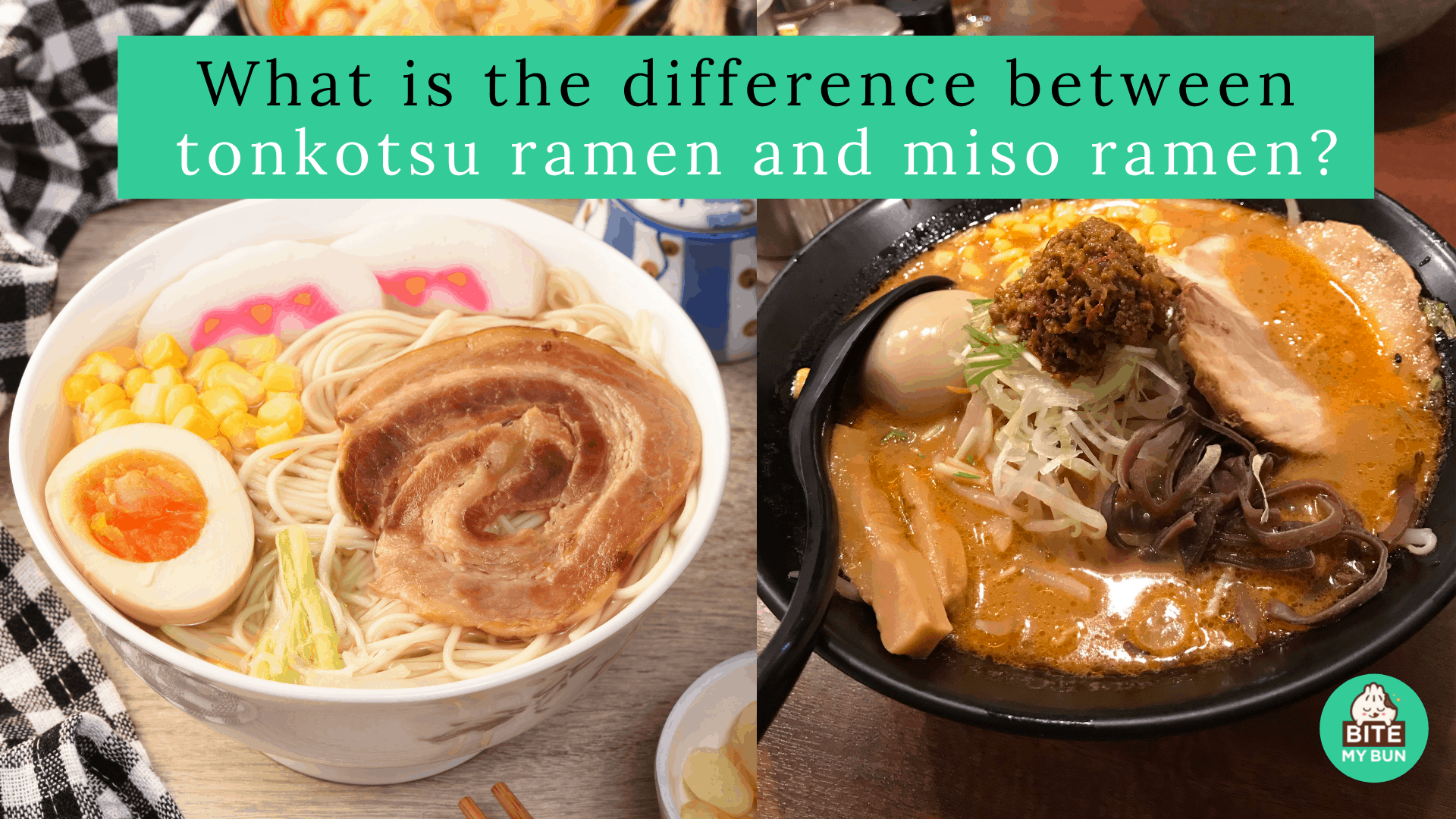What is the difference between tonkotsu ramen and miso ramen?
Ramen is a very customizable dish, and you can even create yours with what’s available in your pantry. But, there are four distinct flavorings that most people universally like: shoyu, shio, tonkotsu, and miso. Though tonkotsu en miso ramen seem so alike?
Tonkotsu ramen uses a pork-based broth, making it cloudy and milky in appearance with a very meaty flavor and a velvety texture. On the other hand, miso ramen uses fermented Japanese soy paste. It also has a thick soup base, but it is more hearty, savory, and slightly sweet.
Let’s look at all the differences between these two hardest ramen to make.


Check out our new cookbook
Bitemybun's family recipes with complete meal planner and recipe guide.
Try it out for free with Kindle Unlimited:
Read for freeIn this post we'll cover:
The different parts of ramen
Due to the number of ramen recipes in the world, categorizing it is a complicated task.
Like in a mix and match game, there are hundreds or thousands of variations, making ramen a very versatile dish. But even this bowl of goodness has baseline rules to follow.
Ramen noodles
To be called a ramen dish, the noodles should be springy and has a distinct texture. Ramen noodles achieve this springy texture by adding kansui to the dough.
Kansui is a salty, alkaline mixture that regulates the acidity of the dough.
The length, color, thickness, or springiness of the noodle doesn’t matter. As long as it contains kansui, it is considered a ramen noodle.
Kansui is also what makes ramen noodles so tasty, almost additive.
Toppings
Ramen toppings can also have a lot of variety due to regional differences in Japan.
From meat-based toppings like Chasu pork to other lighter options like corn and bean sprouts. Fish dishes are also popular in coastal regions.
However, both eggs and nori or seaweed sheets are popular toppings across the country.
Ramen broth
The ramen broth is the most defining ingredient of a ramen bowl. Just like ramen noodles and toppings, there are numerous broth varieties.
The broth can either be chintan (or clear) or paitan (cloudy or milky) in appearance. A dipping sauce (or tare) is more seasoning, which gives the broth its salty flavor.
Miso ramen is a common variety of chintan ramen dishes, while tonkotsu belongs to the paitan ramen category.
Tonkotsu ramen
Tonkotsu ramen is known for its cloudy and milky soup appearance and stickiness. You can easily distinguish it from other ramen broth due to its very distinct porky smell and opaque appearance.
Most ramen cooks use straight noodles for this broth to allow the broth to stick in it.
Broth base
What makes tonkotsu ramen unique is its milky appearance. This appearance comes from hours and hours of boiling pork bones.
Pork bones (typically the hock and trotter) are boiled to the point of emulsion, where the collagen and fat had disintegrated. Both of these ingredients make the broth cloudy and milk-like.
Due to its preparation, a bowl of tonkotsu ramen has a strong meaty flavor. Tonkotsu is a naturally flavorful broth; that’s why most shops only use salt as their tare or seasoning.
Another reason why salt is commonly the tare for tonkotsu is to preserve the broth’s milky appearance. Some shops still add a different shoyu dipping sauce for a condiment.
Take note: tonkotsu is different than tonkatsu, which is a tempura pork cutlet.
A bowl of tonkotsu ramen has the most caloric content among the four ramen varieties, with about 600kcall.
Miso ramen
Miso ramen is a local dish from Sapporo, in Hokkaido. This type of ramen can either be a chintan or paitan, depending on your preference.
It has a more unique flavor profile, which is commonly described as a combination of cheese and nuts. You can also taste a bit of sweetness and tanginess due to the tare, which typically uses miso paste.
Broth base
A bowl of miso ramen is quite popular in the area of Sapporo, where the winters can be heavy.
Unlike tonkotsu ramen, the preparation for miso ramen is quite unique. Chicken or seafood broth is used as a soup body, while the miso paste itself is added as a tare.
Invented during the mid-1960s, miso ramen is considered very young compared to other types of ramen. The broth flavor is often described as hearty and lardy, the perfect comfort food during the cold weather.
Most ramen restaurants would often use their homemade miso paste as a tare. In fact, other types of miso such as red miso, white miso, and charred miso can be used for variety.
Just like other ramen types, you can add Chasu pork, egg, and other typical toppings. But if you like a more authentic experience, consider adding sweet corn, butter, and vegetables.
Miso vs tonkotsu ramen: which one is better?
It really depends on your taste preferences. People who love a meaty and dense broth might prefer the tonkotsu ramen. If you want a no-barred meat explosion, the Hakata-style tonkotsu ramen is highly recommended.
Meanwhile, those who like a bit of flavor variety and experimentation would appreciate miso ramen. The original Sapporo-style miso ramen is still one of the best ramen varieties in the world.
Read next: Japanese Ramen vs Korean Ramen Ramyeon or Ramyun (Is ramen Japanese or Korean?)
Check out our new cookbook
Bitemybun's family recipes with complete meal planner and recipe guide.
Try it out for free with Kindle Unlimited:
Read for freeJoost Nusselder, the founder of Bite My Bun is a content marketer, dad and loves trying out new food with Japanese food at the heart of his passion, and together with his team he's been creating in-depth blog articles since 2016 to help loyal readers with recipes and cooking tips.
